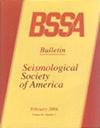注入历史如何影响水力压裂引发的地震:从英国普雷斯顿新路的井下监测中获得的启示
IF 2.9
3区 地球科学
Q2 GEOCHEMISTRY & GEOPHYSICS
引用次数: 0
摘要
2019 年 8 月,英国普雷斯顿新路进行了多级水力压裂(HF)作业。HF 引发了大量地震活动,最终导致 ML 2.9 事件。地震活动由位于附近监测井中的 12 个传感器组成的井下阵列记录。一家服务公司在运行期间实时检测并定位了约 55 556 次事件。在这项研究中,我们首先通过模板匹配来提高检测数量,然后计算相关地震的矩震级。然后我们发现,通过分别分析注入期间和注入后的时间段,可以识别出不同的模式。我们观察到,在注入的后续阶段,地震峰值的延迟增加,振幅减小。注入后,地震衰减可以用 Omori-Utsu 定律来描述。衰减速度随着每次注入而减慢,尤其是在注入的后期阶段。此外,频率-震级分布从锥形分布(缺乏大事件)演变为双线性分布(大事件过多)。这种演变是渐进的,每次注入时角幅度都在增加。我们将这些模式解释为两个因素共同作用的结果:(1)受刺激的体积越来越小,(2)体积逐渐增大,从而增加了在原有断层上发生触发事件的概率。更广泛地说,这些模式表明,注入过程中的地震活动受注入历史的强烈影响,并受应力状态、断层结构和渗透性等当地条件的调节。本文章由计算机程序翻译,如有差异,请以英文原文为准。
How Injection History Can Affect Hydraulic Fracturing–Induced Seismicity: Insights from Downhole Monitoring at Preston New Road, United Kingdom
In August 2019, a multistage hydraulic fracturing (HF) operation was carried out at Preston New Road, United Kingdom. HF caused abundant seismic activity that culminated with an ML 2.9 event. The seismic activity was recorded by a downhole array of 12 sensors located in a nearby monitoring well. About 55,556 events were detected and located in real time during the operation by a service company. In this study, we first improve the number of detections by applying template matching and later calculate the moment magnitude of the associated earthquakes. Then we show that by separately analyzing the periods during and immediately after injection, distinct patterns can be identified. We observe an increase in the delay and decrease in amplitude of peak seismicity during subsequent phases of injection. After injection, the seismicity decay can be described by the Omori–Utsu law. The decay rate tends to slow with each successive injection, in particular during the later injection stages. In addition, the frequency–magnitude distribution evolves from a tapered distribution (lack of large events) to a bilinear distribution (excess of large events). This evolution is gradual, with the corner magnitude increasing with each injection. We interpret these patterns as the result of the combined effect of two factors: (1) the stimulated volume becoming increasingly aseismic and (2) the gradual increase in its size, which increases the probability of triggered events on preexisting faults. More generally, these patterns suggest that seismic activity during injection is strongly influenced by the injection history and is modulated by local conditions such as stress state, fault structure, and permeability.
求助全文
通过发布文献求助,成功后即可免费获取论文全文。
去求助
来源期刊

Bulletin of the Seismological Society of America
地学-地球化学与地球物理
CiteScore
5.80
自引率
13.30%
发文量
140
审稿时长
3 months
期刊介绍:
The Bulletin of the Seismological Society of America, commonly referred to as BSSA, (ISSN 0037-1106) is the premier journal of advanced research in earthquake seismology and related disciplines. It first appeared in 1911 and became a bimonthly in 1963. Each issue is composed of scientific papers on the various aspects of seismology, including investigation of specific earthquakes, theoretical and observational studies of seismic waves, inverse methods for determining the structure of the Earth or the dynamics of the earthquake source, seismometry, earthquake hazard and risk estimation, seismotectonics, and earthquake engineering. Special issues focus on important earthquakes or rapidly changing topics in seismology. BSSA is published by the Seismological Society of America.
 求助内容:
求助内容: 应助结果提醒方式:
应助结果提醒方式:


